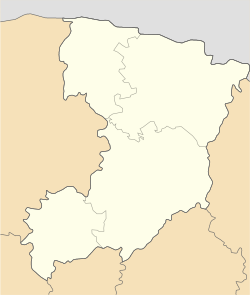| This article needs additional citations for verification. Please help improve this article by adding citations to reliable sources. Unsourced material may be challenged and removed. Find sources: "Zdolbuniv" – news · newspapers · books · scholar · JSTOR (November 2018) (Learn how and when to remove this message) |
| Zdolbuniv ЗдолбунівZdołbunów | |
|---|---|
| City | |
 Skyline of Zdolbuniv Skyline of Zdolbuniv | |
 Coat of arms Coat of arms | |
  | |
| Coordinates: 50°30′34″N 26°15′35″E / 50.50944°N 26.25972°E / 50.50944; 26.25972 | |
| Country | |
| Oblast | Rivne Oblast |
| Raion | Rivne Raion |
| Hromada | Zdolbuniv urban hromada |
| First mentioned | 1497 |
| Population | |
| • Total | 24,501 |
Zdolbuniv (Ukrainian: Здолбунів, IPA: [zdolˈbuniu̯]; Polish: Zdołbunów) is a small city in the Rivne Raion of Rivne Oblast (province) of western Ukraine. It has an important railway station and cement plant (there is a deposit of chalk). Population: 24,501 (2022 estimate).
History

The town was mentioned in 1497 in the deed, in which the Lithuanian Grand Duke and future King of Poland Alexander Jagiellon committed several villages to Prince Konstanty Ostrogski. Among the villages mentioned in the deed was Dolbunov. The town has had its present name of Zdolbuniv since 1629. In 1569, following the Union of Lublin, Zdolbuniv became part of the Kingdom of Poland, where it remained for over 200 years, until the Partitions of Poland. In 1793, it was annexed by the Russian Empire, and in the interbellum period, it again belonged to Poland. It was a powiat (country) centre in Wołyń Voivodeship during this period. Zdołbunów, as it was then known, was an important rail hub, located near the Polish-Soviet border. According to the 1921 census, the town had a mixed population, 40.0% Polish, 31.3% Ukrainian, 10.0% Jewish, 9,0% Russian, 8.9% Czech.
In September 1939, following the Soviet Invasion of Poland, Zdołbunów was captured by the Soviet Union, where it remained until the Operation Barbarossa. Its Jewish minority was murdered in the Holocaust, and in late 1943, Zdołbunów became a shelter for the ethnic Polish population of Volhynia, escaping the Volhynian Genocide. On February 3, 1944, the town was captured by the Red Army, and eventually annexed from Poland.
Prior to the administrative reform of 2020, it was the administrative center of the former Zdolbuniv Raion.
Notable people
Zdolbuniv is the birthplace of a contemporary Polish painter Stanislaw Fijalkowski (1922–2020), and singer Teresa Tutinas (born 1943)
Gallery
-
St. Catherine Church
-
 St. Peter and Paul church
St. Peter and Paul church
-
House of culture and bust of Ulas Samchuk
-
 Zdolbuniv railway station
Zdolbuniv railway station
-
Graves of soldiers of Ukrainian People's Republic
-
Memorial and common grave of Polish soldiers
-
Memorial of World War II soldiers
-
Common grave of World War II soldiers
-
Zdolbuniv cement factory
References
- Чисельність наявного населення України на 1 січня 2022 [Number of Present Population of Ukraine, as of January 1, 2022] (PDF) (in Ukrainian and English). Kyiv: State Statistics Service of Ukraine. Archived (PDF) from the original on 4 July 2022.
- Skorowidz miejscowości Rzeczypospolitej Polskiej (in Polish). Vol. IX. Warszawa: Główny Urząd Statystyczny. 1923. p. 47.